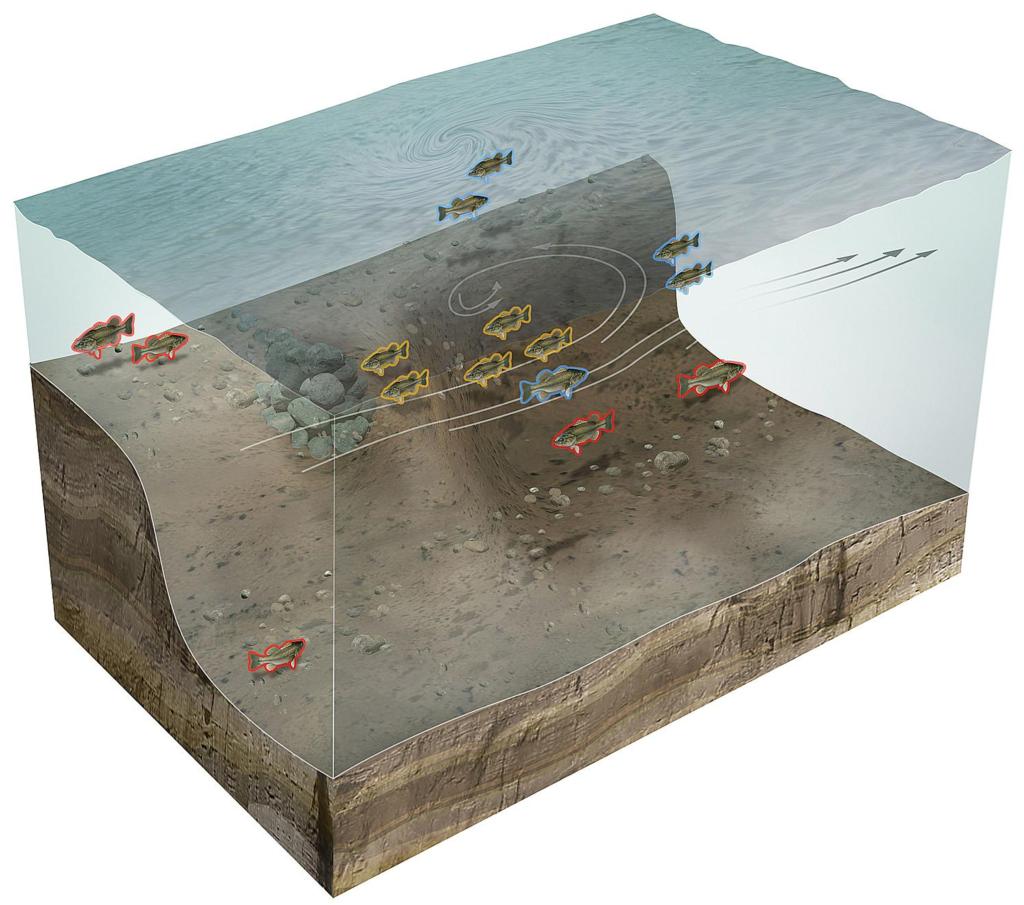The ‘Current’ location
Mark Rose suggests fish location based on current

Predicting bass location on a ledge based on current is not a sure-fire science. Actually, it’s completely unpredictable most of the time. There are just too many variables.
You’ve got to start somewhere, though. Let’s say you located some bass on a ledge in practice and need to relocate them in a tournament when it counts. Current is one of the deciding factors in where to begin the search. The other big feature to consider is baitfish.
Bait can be located with a depth finder. As for current, ledge expert Mark Rose, the Walmart pro from West Memphis, Ark., has three helpful observations regarding how current affects bass location.
Strong current typically forces bass to seek respite in an eddy.
They still want to be in a good ambush position, where the current can sweep food to them. However, ledge bass act like traditional river fish and set up behind something that redirects the flow.
“It might be a ridge, and they’ll be right behind it, where the bait’s coming over the top,” says Rose, “or it might be a rock, where the bait’s coming around and they’re feeding on the bottom.”
Sometimes the structure or cover creating the eddy is large enough to see on a contour map, such as a rock bar or small turn in the original river channel. Other times it’s a small cluster of rocks, a stump, a brush pile, a flooded house foundation or some other element you have to find with electronics or by dragging a lure across bottom.
Fish typically suspend when there is little to no current. They also become difficult to catch because they’re not actively feeding. And they can move away from eddies.
“They don’t have to exert any energy,” says Rose. “They just sit there. There’s no current to fight them.”
Rose has seen bass suspend in nearly any direction in low-flow conditions – straight above the ledge, horizontally off the ledge and out “in space.”
He uses 2-D and 3-D sonar to find them and often tries to trigger some type of activity with his Hydrowave. A spike in bait or bass movement often ignites the school.
“With the Hydrowave, it has their eyes looking up; it’s got the bait around them moving around,” he says. “I think they’re kind of like fire ants: If something moves, they all move; when one bites, they’re all going to bite.”
There are no “rules.” Fish might be anywhere at any time.
“As I always say, there are general rules of thumb, but don’t let them be your end-all,” Rose says. “There have been so many times when I’ve found a bar or rock pile running parallel with the flow, when you’d think they’d be on the end of it based on the `rules,’ but instead fishing on the top half of it is unbelievable, or maybe they’re on the front of a rock pile or hump.”
Rose suggests that if conditions seem right for bass to feed, but they’re not where you left them, look far and wide before giving up. Drag a football jig off the deep end of the drop. Cast a crankbait up into 5 feet of water. Look up and down the ledge. Sometimes their location is entirely unpredictable.
“There’ve been times when I’ve found the mother lode and I’ve got the cast lined up, and I’ve gone out there the next day and they’re just not there,” Rose says. “In that scenario I’m not leaving. The bait might have moved, so therefore the bass might have moved. There are times when they might be just a cast away.”
One more tip: As an all-around outdoorsman, Rose offers some advice for anglers that he has learned throughout his hunting and fishing career: Change is often the best starting point.
What’s it mean?
When all else is the same, the best way to predict fish or game activities is to watch for changes in weather, water conditions, moon phases, air pressure or, in this case, current.
“The sudden arrival of current after you’ve had none is always the best condition,” Rose says. “The worst current is when it’s running 24/7. The sudden influx of current is always better. That goes whether you’re on a TVA system or on the Potomac and dealing with tide. It’s always best when there’s a change. When it’s steady, they get accustomed to it and they feed whenever they want to. They have no time schedule. As outdoorsmen, we need something to go by. And when you don’t have any kind of current schedule to set your clock by, or even give you a good conscious guess, you have to randomly guess when they’re going to feed.”
Just as humans prefer to eat according to a schedule, bass do too. So study the local power generation schedules, and be ready to act when the current starts to move. There’s no better time to fool hungry bass.